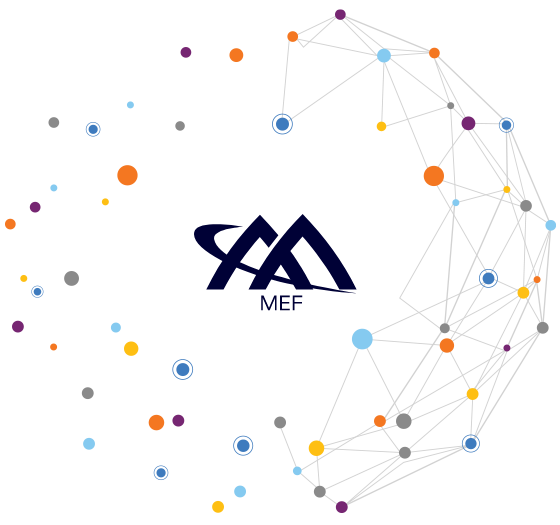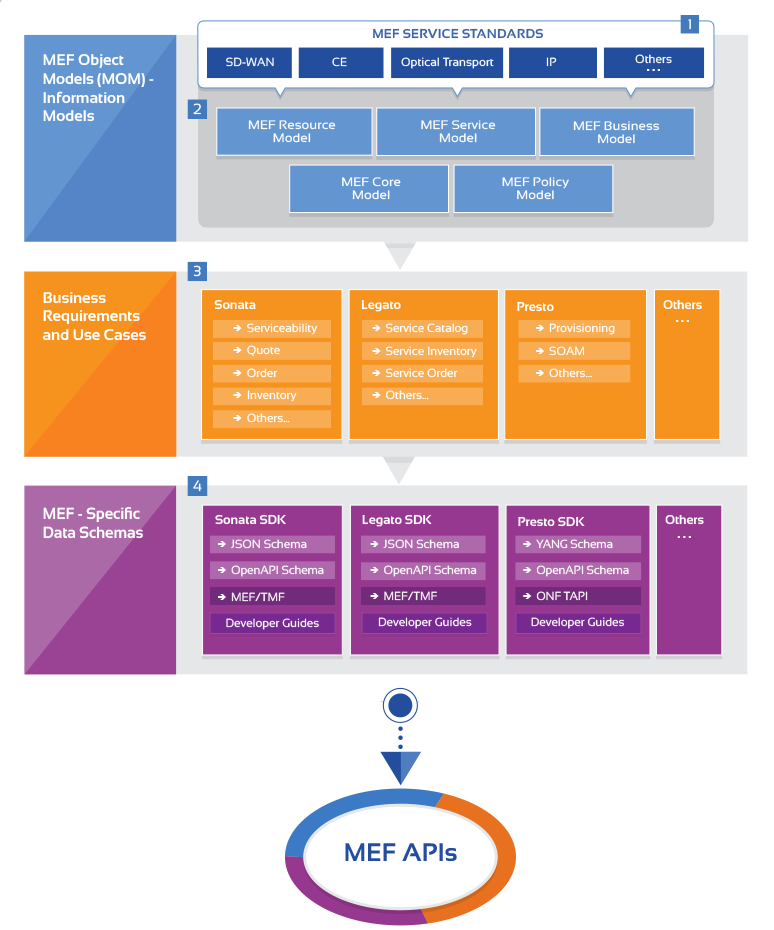Our suite of object models supporting MEF’s LSO APIs, lovingly referred to as ‘MOM,’ is composed of five information model groups:
With the information models in-hand, MEF then defines and documents the business requirements and use cases (BRUC). The models are generic, whereas the BRUC takes the information and applies it to the specific LSO reference points (e.g. LSO Presto, LSO Sonata, LSO Interlude, etc.). Thus a formal definition of the requirements and use cases is defined for each LSO reference point.

With the BRUC, the data models and APIs are developed. The APIs use the UML information from the models, plus the requirements and use cases, and maps these to specific data schemas. Using tooling and/or manual effort, MEF, in collaboration with other industry bodies, develops reference implementations.
For example, the industry has adopted NETCONF/YANG at the LSO Presto reference point. In the case of LSO Presto, the APIs are built using ONF transport APIs (ONF-TAPI), adding the MEF-specific value-added elements to these existing APIs. This collaboration accelerates development and enhances adoption—a key element of our MEF 3.0 Global Services Framework’s community pillar.
See MEF’s Technical Standards & Educational Materials for Models
The MEF Core Model (MCM) is the information model describing the base set of object definitions and relationships supporting the concepts defined in the LSO Reference Architecture (MEF 55). MCM formalizes the diverse concepts in the LSO Reference Architecture into a coherent, object-oriented information model, which acts as the source of key concepts and functions that can be reused or refined across all MEF definition projects.
MCM uses Unified Modeling Language (UML) to describe the salient characteristics and behaviors of entities that are important in a managed environment and acts as a common lexicon for all MEF models.
The MEF Policy Model (MPM) standardizes the object-oriented technology-neutral information model for representing different types of policies used in the MEF LSO Architecture. Currently, the focus is on imperative and intent policies.
Many service providers and technology vendors implement policy management solutions. However, the standards-based approach encapsulated in MPM that specifies an architecture with an associated information model is essential to ensure interoperability.
This unified and standardized approach to policies will be even more important with the emergence and growth of policy-oriented services like SD-WAN, SASE and Zero Trust Network Access.
The MEF Services Model (MSM) is the collection of service models, which generally map one-to-one to the service standards (e.g. MEF 3.0 SD-WAN, Carrier Ethernet) defined by MEF in the context of the MCM. MSM is designed to be leveraged at multiple LSO Reference Points (e.g. LSO Sonata, LSO Legato, LSO Interlude, LSO Allegro) to develop APIs at each of these reference points with common objects, attributes, and relationships.
MEF Service Models are also key to the development of the MEF product payloads used in the East-West APIs (e.g. LSO Cantata, LSO Sonata).
The MEF Resources Model (MRM) is a collection of resource models that leverage the common constructs of MCM, adding information relevant to how you provision the resources (e.g. provision a Carrier Ethernet EVC). It also includes Operations, Administration, and Maintenance (OAM), and other elements related to the various MEF 3.0 services.
MRM provides a resource-oriented view at the network level, and can be used as the basis for LSO Presto interface profiles defining LSO Presto APIs.
The MEF Business Model is the collection of object-oriented information models identifying the commercial attributes and characteristics needed to order products and exchange business-level information between providers as well as with the subscriber or customer.
1To facilitate automation, MEF begins with the definition and standardization of MEF 3.0 services.
2From these service definitions, information or object models are developed. These include common MEF types and constructs and a common taxonomy and behavior that span all MEF 3.0 services.Specific resource, service, policy, and business model representations are developed for each MEF 3.0 service. Some of these models relate to more than one LSO interface reference points (e.g. There is a significant overlap of product models applied at LSO Sonata and Cantata).
3The Business Requirements and Use Cases (BRUC) are specific to each LSO interface reference point and they define the functional requirements, use cases, business process flows, state transitions, etc., related to the specific LSO interface (e.g. LSO Sonata).
4From these BRUCs, MEF maps the applicable information models to relevant data schemas which are then packaged into SDKs along with related documentation, code samples, and developer guides, to support the development of MEF APIs for each of the LSO interface reference points.
MEF incorporates industry work, in a collaborative manner, to leverage ongoing projects in specific domains, e.g TMF Open APIs, ONF TAPI, that facilitate rapid and frictionless adoption with industry stakeholders.
To support automation within and between providers, both the services and the information models need to be standardized.
From Service Standards to Standard APIs

To facilitate automation, MEF begins with the definition and standardization of MEF 3.0 services.
From these service definitions, information or object models are developed. These include common MEF types and constructs and a common taxonomy and behavior that span all MEF 3.0 services.Specific resource, service, policy, and business model representations are developed for each MEF 3.0 service. Some of these models relate to more than one LSO interface reference points (e.g. There is a significant overlap of product models applied at LSO Sonata and Cantata).
The Business Requirements and Use Cases (BRUC) are specific to each LSO interface reference point and they define the functional requirements, use cases, business process flows, state transitions, etc., related to the specific LSO interface (e.g. LSO Sonata).
From these BRUCs, MEF maps the applicable information models to relevant data schemas which are then packaged into SDKs along with related documentation, code samples, and developer guides, to support the development of MEF APIs for each of the LSO interface reference points.
MEF 95.0.1 Amendment to MEF 95: Policy Driven Orchestration — 2022 Oct
Amends: MEF 95
Product Portfolio: Models
This amendment provides enhancements to MEF 95 that enables policies to be grouped and defines the semantics of this grouping.
MEF 112 MEF Services Model: Information Model for IP/IP VPN — 2022 Jul
Tags: MSM (MEF Service Models)
The MEF Services Model (MSM) is an information and data model for MEF defined services. The object definitions, object attributes and relationships specified in the MSM are based on MEF standards that define the given services.
MEF 89 Resource Model – Common — 2022 Jan
Product Portfolio: Models
Tags: MRM (MEF Resource Models)
This Standard describes the MEF Resource Model (MRM) Common, which essentially is the selection of ONF Transport API Information Model currently used and extended by more specific MEF Resource Models like Ethernet Connectivity Info Model (MEF 59), Subscriber and Operator Layer 1 Info Model (MEF 72.1), Ethernet OAM Info Model (MEF 83); and potentially useful for the Resource management at PRESTO IRP.
MEF 95 MEF Policy Driven Orchestration — 2021 Jul
Amendments: MEF 95.0.1
Product Portfolio: Models
The MEF Policy Driven Orchestration (PDO) standard specifies how Policy-based management and modeling can be used to realize and augment the orchestration functionality defined in the MEF Lifecycle Service Orchestration (LSO) Reference Architecture (RA), MEF 55.1. It may also be used to define other types of services, such as choreography and collaboration.
MEF 72.1 Resource Model – Subscriber & Operator Layer 1 — 2021 Feb
Product Portfolio: Optical Transport, Models
Tags: NRP (Network Resource Provisioning), MRM (MEF Resource Models)
This Standard describes the MEF Resource Model (MRM), specifically for Layer 1 Connectivity related management features.
I want to investigate further. See all Models resources:
MEF’s Object Models (MOM) provide the foundation for software architects and developers that need to understand MEF LSO APIs and successfully implement the relevant APIs for their business.
We invite software architects and professionals in related fields to advance the foundation of our industry’s automation by joining MEF’s on-going modelling projects. Join a call, comment on draft work or launch a new initiative that supports your company objectives and the industry. As a MEF member, you can access the latest projects in the MEF 3.0 Object Models Hub on the MEF Members’ Wiki.
All employees of active MEF-member companies are authorized to access MEF Members’ Wiki. Don’t have a login? Register. Not a member? Join MEF. Not sure? Contact Us.
Go to the Member Wiki